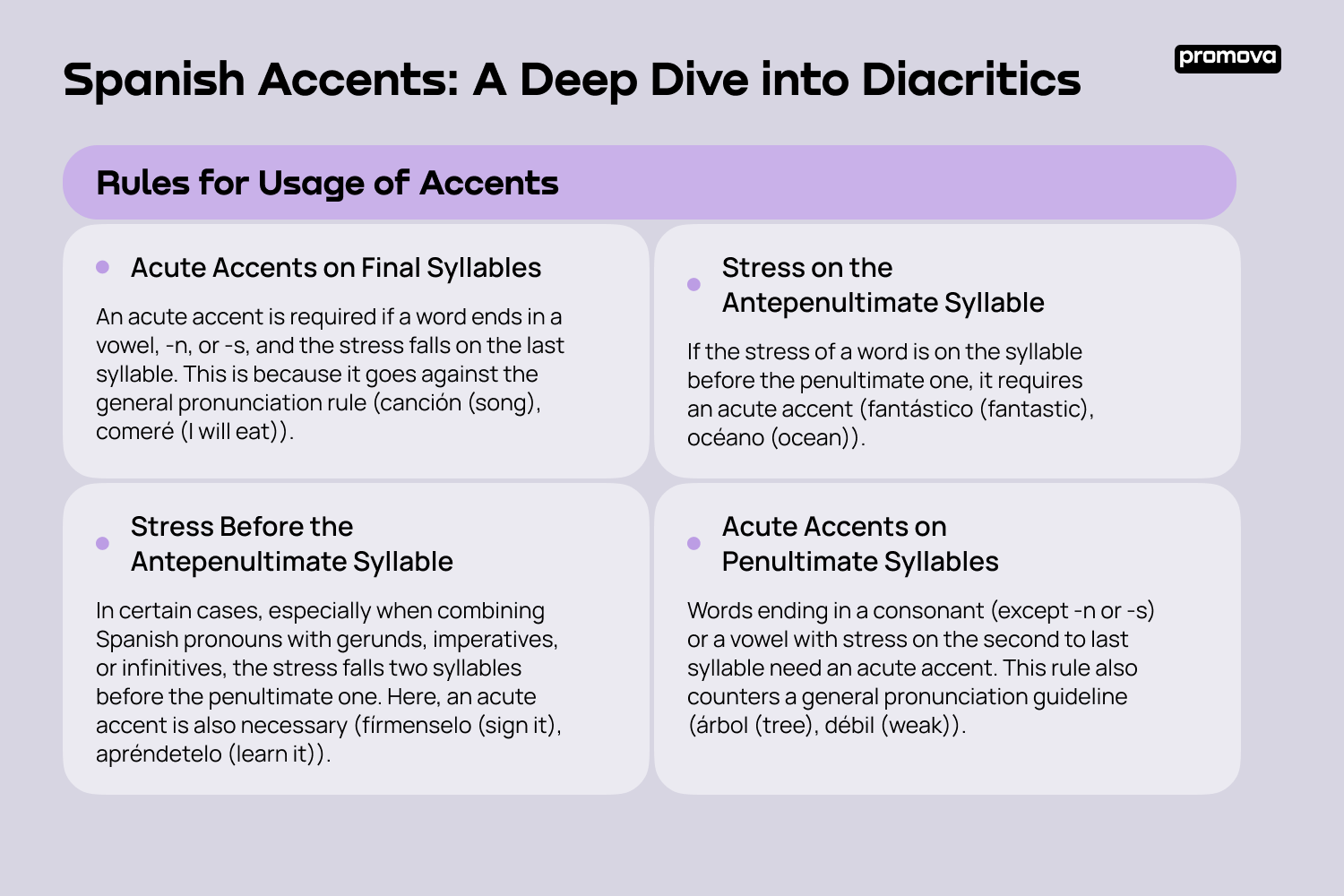Spanish Accents: A Deep Dive into Diacritics


You will get a promo code with a discount for our app courses after reading this article.
Contents
Diacritics play a crucial role in the Spanish language. They are more than decorations; they influence pronunciation, meaning, and sometimes even verb tense. Understanding the ins and outs of Spanish accents may seem daunting. However, gaining command of diacritics will add nuance to your language abilities. Keep reading this guide to learn about the variety of Spanish accents, their rules, and implications.
Historical Evolution of Accents in Spanish
The history of accent marks in Spanish is intertwined with the evolution of the language itself. As Latin transformed into the various Romance languages, including Spanish, the need for clearer pronunciation and differentiation of words became evident. Diacritics emerged as a solution to these linguistic challenges.
In the early days of written Spanish, scribes often used accents to distinguish between homonyms. For instance, ‘más’ (more) was differentiated from ‘mas’ (but). Such distinctions were crucial to avoid misunderstandings in both spoken and written communication.
For instance, the acute accent, perhaps the most common diacritic in Spanish, originates in ensuring clarity of stress placement. In a language where word stress can change the meaning or tense of a word, indicating the correct stress becomes vital. For example, ‘hablo’ (I speak) and ‘habló’ (he/she spoke) are differentiated only by the accent.
Over time, as the Spanish language spread across continents, regional variations began to emerge. These variations further underscored the importance of diacritics in maintaining clarity and uniformity. Today, while some modern dialects and colloquial forms of Spanish may overlook certain diacritics, their role in formal, written Spanish remains as crucial as ever.
Spanish Letters with Accents: Exploring The Types of Diacritics
At the heart of Spanish diacritics are three primary accent types: tilde (ñ), the acute accent that often corresponds with spoken stress (á, é, í, ó, ú), and the diaeresis (ü). Each of these accents serves a distinct purpose, guiding both native speakers and learners in articulating words correctly. In total, there are seven Spanish accented letters: á, é, í, ó, ú, ñ, and ü. So, let’s explore diacritics in more detail.
Diaeresis
The diaeresis, represented by two dots (¨) placed over the letter ‘u,’ is a unique diacritic in the Spanish language. Its primary function is to signal that the ‘u’ should be pronounced in places where it would typically be silent. For instance, in the word ‘güero,’ without the diaeresis, the ‘u’ would be silent, and the word would sound like ‘gero.’ However, with the diaeresis, both the ‘g’ and the ‘u’ are pronounced, resulting in the correct ‘güero’ (‘blond’).
While the diaeresis is not as commonly used as some diacritics, its presence is essential for accurate pronunciation of specific words. It ensures that the surrounding letters do not overshadow the ‘u,’ especially after a ‘g’ and before an ‘e’ or ‘i.’
Tilde
The tilde, a small squiggly line, is exclusively used atop the letter ‘n’ in Spanish, transforming it into ‘ñ.’ This diacritic introduces a new sound altogether. While ‘n’ is pronounced similarly to the English ‘n,’ the ‘ñ’ has a distinct ‘ny’ sound, as in ‘canyon’.
The distinction is crucial in differentiating words. For example, ‘mañana’ means ‘morning,’ whereas ‘manana’ would mean ‘tomorrow.’ The tilde, in this case, not only changes pronunciation but also ensures clarity in meaning. It’s worth noting that ‘ñ’ is considered a separate letter in the Spanish alphabet, further highlighting its significance.
Acute Accents
Acute accents are the most prevalent diacritics in Spanish. They appear as a small diagonal line, slanting from the bottom left to the top right, and can be found over any vowel: á, é, í, ó, and ú. Their primary role is to indicate stress on a particular syllable. In Spanish, word stress can alter meaning, making these accents indispensable.
For instance, ‘papa’ means ‘potato,’ but with an acute accent on the first ‘a,’ ‘papá,’ it means ‘father.’ Similarly, ‘si’ translates to ‘if,’ but ‘sí’ with an accent means ‘yes.’ These symbols not only guide pronunciation but also help in distinguishing between homonyms.
Rules for Usage of Accents
Spanish symbols are governed by specific rules that determine their placement in words. Understanding them is essential for anyone aiming to master Spanish. So, here are the rules:
- Acute Accents on Final Syllables. An acute accent is required if a word ends in a vowel, -n, or -s, and the stress falls on the last syllable. This is because it goes against the general pronunciation rule (canción (song), comeré (I will eat)).
- Acute Accents on Penultimate Syllables. Words ending in a consonant (except -n or -s) or a vowel with stress on the second to last syllable need an acute accent. This rule also counters a general pronunciation guideline (árbol (tree), débil (weak)).
- Stress on the Antepenultimate Syllable. If the stress of a word is on the syllable before the penultimate one, it requires an acute accent (fantástico (fantastic), océano (ocean)).
- Stress Before the Antepenultimate Syllable. In certain cases, especially when combining Spanish pronouns with gerunds, imperatives, or infinitives, the stress falls two syllables before the penultimate one. Here, an acute accent is also necessary (fírmenselo (sign it), apréndetelo (learn it)).
Exceptions do exist, especially with words ending in -mente. Such words have two stressed syllables, complicating accent placement. A practical approach is removing the -mente ending, applying the standard rules to determine symbol placement, and reattaching the ending.
Furthermore, it’s essential to note that all Spanish interrogative words require an acute accent. This rule applies even if the same word doesn’t have the symbol when used in a declarative context. (¿Quién? (who?), ¿Qué? (what?)).

Homonyms and Spanish Accent Marks
Homonyms in any language can be a source of confusion, especially for learners. In Spanish, this potential for misunderstanding is addressed, in part, through the use of accent marks. Here are some notable examples:
- Si (if) vs. sí (yes).
- El (the) vs. él (he).
- Mas (but) vs. más (more).
- Te (you) vs. té (tea).
- Mi (my) vs. mí (me).
It’s worth noting that the tilde in ‘ñ’ creates a distinction that goes beyond the realm of homonyms. The Spanish alphabet considers the letter ‘ñ’ separate from ‘n’.
In essence, accent marks in Spanish serve as invaluable tools in navigating the language’s intricacies. They provide clarity, eliminate ambiguities, and accurately convey the intended message.
Writing Spanish Accents on Keyboard
Knowing the shortcuts to input Spanish symbols is invaluable for those who frequently type in Spanish on a PC. While the Spanish keyboard layout offers direct access to these characters, those using standard English keyboards often need alternative methods. Thankfully, there are a series of keyboard shortcuts and special character codes for typing Spanish accents.
To type Spanish vowels with acute accents, you must hold down the ‘Ctrl’ key and the apostrophe (’) key simultaneously. After releasing both keys, press the desired vowel.
If you wonder how to write n in Spanish, here’s an explanation: Hold down ‘Ctrl’ and the tilde (~) key together, release, and press ‘n.’ The result is the Spanish character ‘ñ.’
However, another efficient method involves using the Alt key in combination with specific numeric codes. It’s essential to use the numeric keypad, typically located on the right side of standard keyboards, for this method. Here are the codes for the most common Spanish characters:
- á: Alt + 0225.
- é: Alt + 0233.
- í: Alt + 0237.
- ó: Alt + 0243.
- ú: Alt + 0250.
- ñ: Alt + 0241.
- ü: Alt + 0252.
- ¡: Alt + 0161.
- ¿: Alt + 0191.
By familiarizing yourself with these shortcuts and codes, typing in Spanish becomes a smoother experience. Whether drafting an email, writing an essay, or chatting with friends, these keyboard techniques ensure you convey your message accurately and authentically.
11
Promova – Your One-Stop Solution for Language Learning
Are you ready to take your language skills to the next level? Look no further than Promova, the ultimate language learning platform. Whether you’re a beginner or an advanced learner, Promova has resources to enhance your language proficiency.
With our guided courses on the Promova app and website, you can access well-structured lessons covering vocabulary, grammar rules, and interactive quizzes. You can learn quickly and tailor your experience to suit your needs.
Then, when it comes to English, Promova goes the extra mile with group classes and personalized 1x1 lessons taught by experienced tutors. You can improve your conversational skills and receive individualized feedback to help you excel in English. And the best part? After signing up, you’ll get a free personal lesson with one of our English tutors!
We also offer a weekly free Conversation Club in English, where you can practice speaking with other learners in a supportive environment. It’s a great way to sharpen your language skills and make new friends worldwide.
And if you’re looking for additional learning resources, check out our regularly updated blog. From language tips and tricks to the discovery of English accent types, the Promova blog supplements your language journey.
Conclusion
Spanish accent marks are pivotal in shaping the language’s clarity and rhythm. These diacritics guide pronunciation, differentiate meanings, and ensure effective communication. As we’ve delved into their history, rules, and Spanish accent keyboard typing techniques, the importance of these symbols becomes evident. So, while it might take some effort to get used to these shortcuts, it’s worth it. With practice, typing Spanish accents becomes second nature, enhancing your writing and communication.
Use your discount and learn languages with Promova
Start learningFAQ
How do Spanish accent marks compare to those in other Romance languages?
Each language has developed its system of diacritics to address its unique linguistic needs. While Spanish uses primarily the acute accent, other Romance languages like French and Portuguese employ a wider variety of diacritics, including grave and circumflex accents.
How have Spanish accent marks evolved with the advent of digital communication?
With the rise of digital communication, there’s been a trend, especially among younger generations, to omit accent marks in informal settings like texting or social media. However, the correct use remains standard in formal writing and publications.
Are there tools that can automatically correct Spanish accent marks?
Many word-processing software programs have built-in spell checkers that recognize Spanish and suggest or automatically correct symbols. Additionally, tools like Grammarly offer Spanish language settings that can help with accent placement.
What are some useful resources for Spanish learners?
Several resources are available online for learning Spanish, including dictionaries like WordReference. These platforms offer detailed explanations of word meanings, including the correct usage of accent marks. Also, the Promova Spanish language learning app provides comprehensive lessons covering different aspects of the Spanish language.



Comments